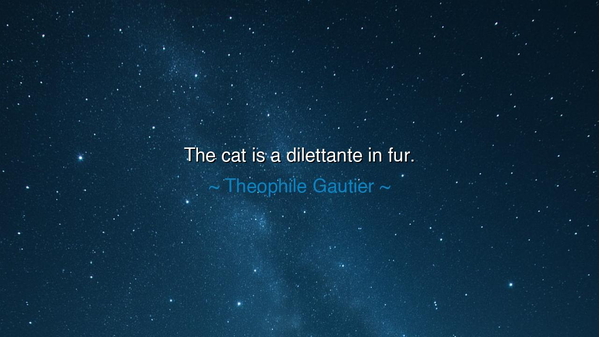
The cat is a dilettante in fur.






Hear, O seekers of quiet wisdom, the words of Théophile Gautier, poet of beauty and lover of grace: “The cat is a dilettante in fur.” At first the saying seems clothed in jest, yet it glimmers with truth both delicate and profound. For in this phrase, Gautier unveils the secret of the cat: it is a creature of refinement, a connoisseur of idleness and delight, an artist of repose. To call it a dilettante is not to scorn it, but to recognize in it the essence of one who lives not for labor alone, but for the savoring of life’s subtler pleasures.
The cat, unlike the dog of duty or the ox of toil, does not measure its worth by service. It chooses when to hunt, when to play, when to offer affection, when to retreat. It embodies the spirit of freedom, of selectiveness, of an artist who dabbles here and there, but always with elegance. The cat is never frantic, never hurried. It is a wanderer of moods, a master of luxury, and yet in all its seeming idleness there is style, there is grace, there is mastery of living.
Gautier, writing in the nineteenth century, belonged to an age that both revered art and questioned labor’s endless grind. He saw in the cat a symbol of the aesthete—the soul who prefers beauty over burden, leisure over drudgery, refinement over rough necessity. To call it a “dilettante in fur” is to say: here is the artist of the everyday, cloaked in softness, making of every gesture a performance, of every pause a philosophy. The cat is, in truth, an aristocrat of existence.
History itself bears this out. In the courts of ancient Egypt, cats were revered, adorned, even worshipped, for they carried themselves not as beasts of burden, but as creatures of mystery and majesty. To live alongside them was to learn that life is not merely toil, but also repose and reverence. When a cat stretched in the sunlight of the temple, it seemed to say to men: “Work if you must, but never forget to live.” Thus Gautier’s playful line is but a modern echo of an ancient truth—that the cat is teacher as well as companion.
Consider also the artists and poets who kept cats as their muses. Baudelaire, Colette, Hemingway—all found in their feline companions a mirror of their own temperaments. The cat does not submit, but chooses. The cat does not rush, but savors. And in watching them, humans learned the lesson of leisure: that beauty comes not only from the grand effort, but from the quiet savoring of simple things. To call a cat a dilettante is to acknowledge that it lives life as art, without apology.
The lesson for us is clear: do not despise leisure. Do not measure your days only by productivity, nor your worth only by labor. To live well is not only to sweat and strive, but to pause, to enjoy, to notice. The cat reminds us that life’s richness lies as much in savoring as in striving. To be always busy is to forget to live. To cultivate moments of leisure is to nourish the soul.
Practically, this means carving out spaces of beauty in your life. Read not only for knowledge but for joy. Rest not only for recovery but for wonder. Surround yourself with small comforts, and do not apologize for cherishing them. Like the cat, learn to be selective in your energy, graceful in your actions, and unapologetic in your love of comfort and beauty.
So, O listeners, take Gautier’s wisdom into your hearts: “The cat is a dilettante in fur.” Let it remind you that life is not only about toil, but about the art of living well. To be a dilettante in this sense is not to waste life, but to elevate it—to make even leisure a form of artistry. And if you learn this from the cat, then your days, too, will carry not only labor, but grace.
––






AAdministratorAdministrator
Welcome, honored guests. Please leave a comment, we will respond soon